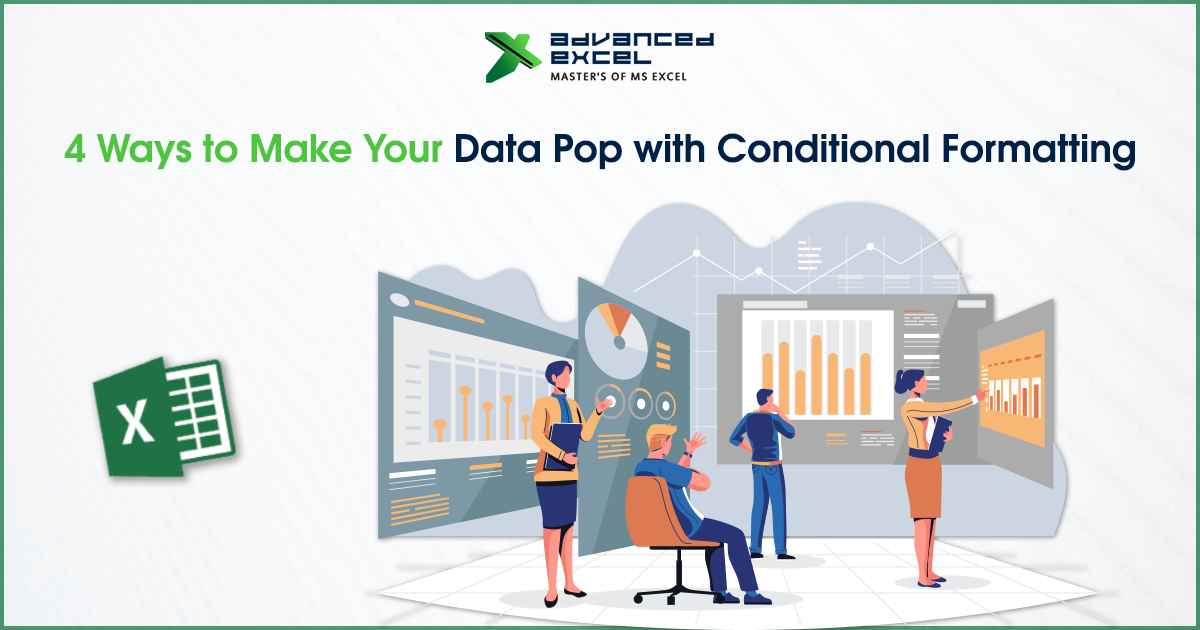Have you ever stared at a massive dataset, trying to understand it all? Raw data can be overwhelming, but you can turn it into a visually engaging masterpiece with the right tools. One such tool is conditional formatting. This article will explore four ways to make your data pop using conditional formatting techniques.
Data is at the heart of decision-making in various fields, from business and finance to healthcare and education. However, data alone may not always convey the insights we need. This is where data visualization comes in. By visually representing data, we can more effectively uncover patterns, trends, and outliers. It is a powerful feature that helps us achieve just that.
What is Conditional Formatting?
Conditional formatting is an advanced feature available in many spreadsheet software programs, most notably Microsoft Excel. It allows users to apply formatting rules to cells based on their content, creating visual cues that highlight important information. This technique, taught in Advanced Excel Classes in Gurgaon and other locations, enables data analysts and decision-makers to quickly identify patterns, trends, and exceptions within large datasets.
Importance of Data Visualization
Data visualization plays a crucial role in data analysis and decision-making. It simplifies complex information and enhances understanding. By using visual elements like colors, icons, and bars, we can present data more easily and engagingly. It is here that conditional formatting comes into play, enabling us to transform raw data into visually appealing and meaningful representations.
Benefits of Conditional Formatting
1. Highlighting Important Data
It allows you to emphasize critical data points instantly. By assigning specific formats, such as bold text or bright colors, to specific conditions, you can draw attention to important values or outliers. It helps viewers focus on the most crucial aspects of the data.
2. Identifying Patterns and Trends
With formatting, you can spot patterns and trends within your data. By applying color gradients or data bars to cells, you can visualize the distribution and relative values, making it easier to identify highs, lows, and significant changes.
3. Enhancing Readability
Formatting techniques like conditional formatting enhance the readability of your data. Using contrasting colors and font styles can make your data more accessible and easier to comprehend. It is particularly useful when presenting reports or dashboards to stakeholders.
4. Improving Decision Making
Well-presented data leads to better decision-making. Using formatting, you can transform complex datasets into intuitive visuals that convey the underlying insights efficiently. It also empowers decision-makers, including those who have attended Excel classes in Gurgaon, to grasp information quickly and make informed decisions based on its visual cues.
How to Use Conditional Formatting
1. Applying Conditional Formatting in Excel
Conditional formatting is widely used in Microsoft Excel, making it a versatile tool for data visualization. To apply conditional formatting in Excel, select the range of cells you want to format, go to the “Home” tab, and click the “Conditional Formatting” button. Choose the desired formatting rule from the drop-down menu or create a custom formula.
2. Creating Rules and Formulas
You can create rules and formulas based on specific criteria when applying formatting. For example, you can highlight cells with values above or below a certain threshold, display color scales based on relative values, or use icons to represent different data categories. Experiment with different rules to find the most effective way to visualize your data.
3. Choosing Formatting Options
It offers various formatting options to customize the appearance of your data. You can choose from various colors, font styles, data bars, color scales, and icon sets. Consider the context of your data and the message you want to convey when selecting the formatting options. Remember to keep the visuals clear and meaningful without overwhelming the viewer.
Tips for Effective Conditional Formatting
1. Understand Your Data
Before applying conditional formatting, take the time to understand your data. Identify the key variables, trends, and outliers you want to highlight. This understanding will guide you in creating appropriate formatting rules and choosing the right visualization techniques.
2. Use Appropriate Formatting Techniques
Different datasets and objectives require different formatting techniques. For numerical data, color scales or data bars can effectively represent relative values. Using icons or formatting based on specific text or value conditions can be more suitable for categorical data. Choose the technique that best aligns with your data and communication goals.
3. Test and Refine Your Formatting
After applying conditional formatting, review and test your visualizations. Ensure that the formatting accurately represents the insights you want to convey. Adjust the formatting rules or styles to enhance clarity and visual impact. Seek feedback from colleagues or stakeholders to gather different perspectives and refine your visualizations further.
Making Your Data Shine
Conditional formatting is a valuable tool for transforming raw data into visually engaging representations. By highlighting important data, identifying patterns and trends, enhancing readability, and improving decision-making, conditional formatting allows you to make your data pop and convey insights effectively. Experiment with different formatting techniques, keep your audience in mind, and continuously refine your visualizations to maximize their impact.
If you want to master the art of conditional formatting in Excel, consider Excel Training in Delhi by Advanced Excel Institute. They provide comprehensive courses and workshops covering various Excel aspects, including conditional formatting. Whether you’re a beginner or an advanced user, these training programs can equip you with the knowledge and skills to leverage conditional formatting effectively in your data analysis.





